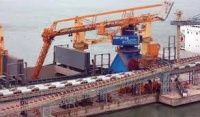Difference between revisions of "Mechanical Continuous Ship Unloaders"
Jump to navigation
Jump to search
PurplePen19 (talk | contribs) |
|||
| Line 1: | Line 1: | ||
[[Category: Loading and Unloading Equipment]]{{Knoppen}} | [[Category: Loading and Unloading Equipment]]{{Knoppen}} | ||
[[File:Mechanical Continuous Ship Unloaders_1.jpg|thumb|200px|right|Mechanical Continuous Ship Unloaders]] | [[File:Mechanical Continuous Ship Unloaders_1.jpg|thumb|200px|right|Mechanical Continuous Ship Unloaders]] | ||
'''Mechanical Continuous Ship Unloaders''' are designed to handle a wide range of free- | '''Mechanical Continuous Ship Unloaders''' are designed to handle a wide range of free-flowing bulk materials. The automatic sink-in system of the unloader allows the intake boot to maintain the optimal position inside the bulk material. It also enables automatic unloading down to the minimum bulk material level inside the ship’s hold. | ||
The possible movements of: | The possible movements of: | ||
Latest revision as of 08:22, 12 November 2013
Mechanical Continuous Ship Unloaders are designed to handle a wide range of free-flowing bulk materials. The automatic sink-in system of the unloader allows the intake boot to maintain the optimal position inside the bulk material. It also enables automatic unloading down to the minimum bulk material level inside the ship’s hold.
The possible movements of:
- displacing the ship unloader
- lifting, lowering, and swiveling the boom
- kick-in/kick-out of the marine leg provide a large working range inside the ship’s hold.
These movements can also be remotely controlled by radio, increasing unloading throughputs and reducing berthing times
Advantages
- Reliable operation even when handling materials with varying characteristics
- Low sensitivity to foreign matter
- Fast changing of chain links
- Easy operation
- Proven engineering with matured mechanical elements
- Low energy consumption
- Less wear and tear
- Long service life of the conveying chains
